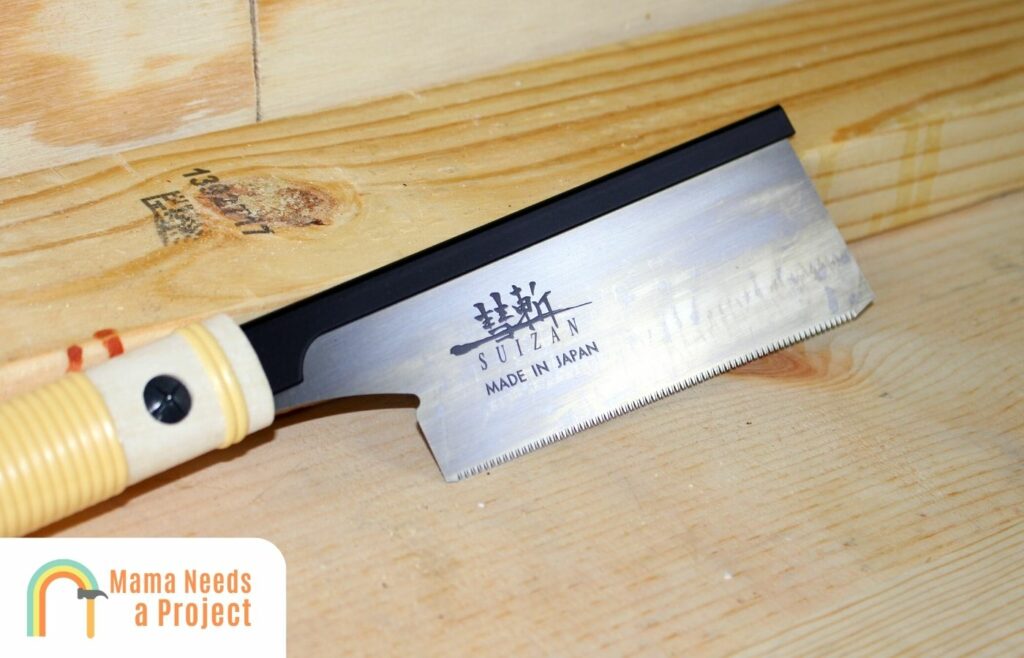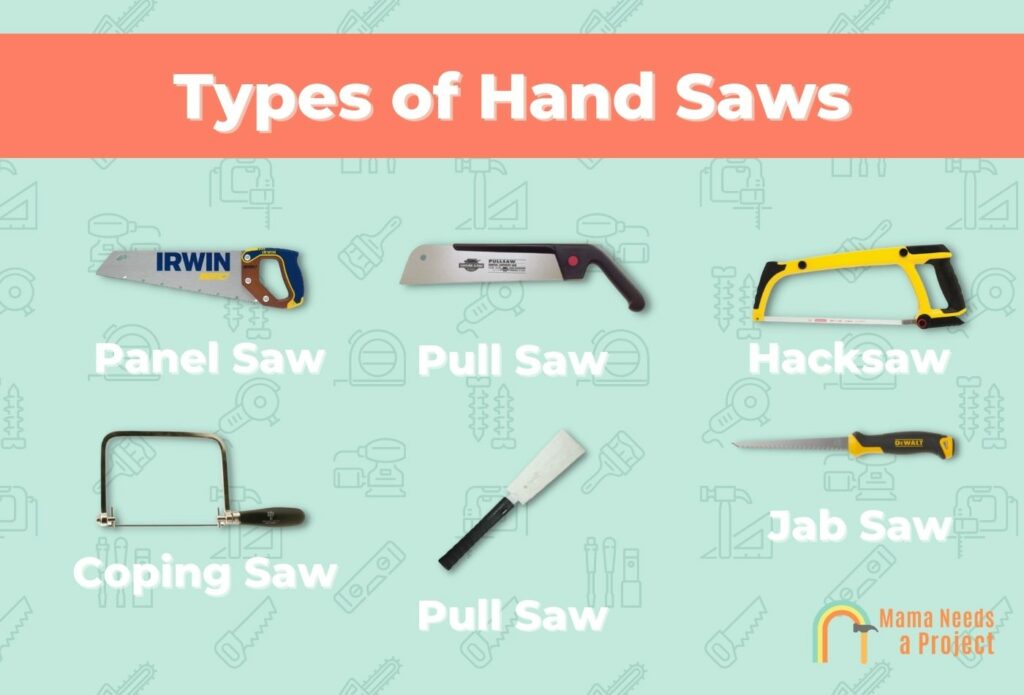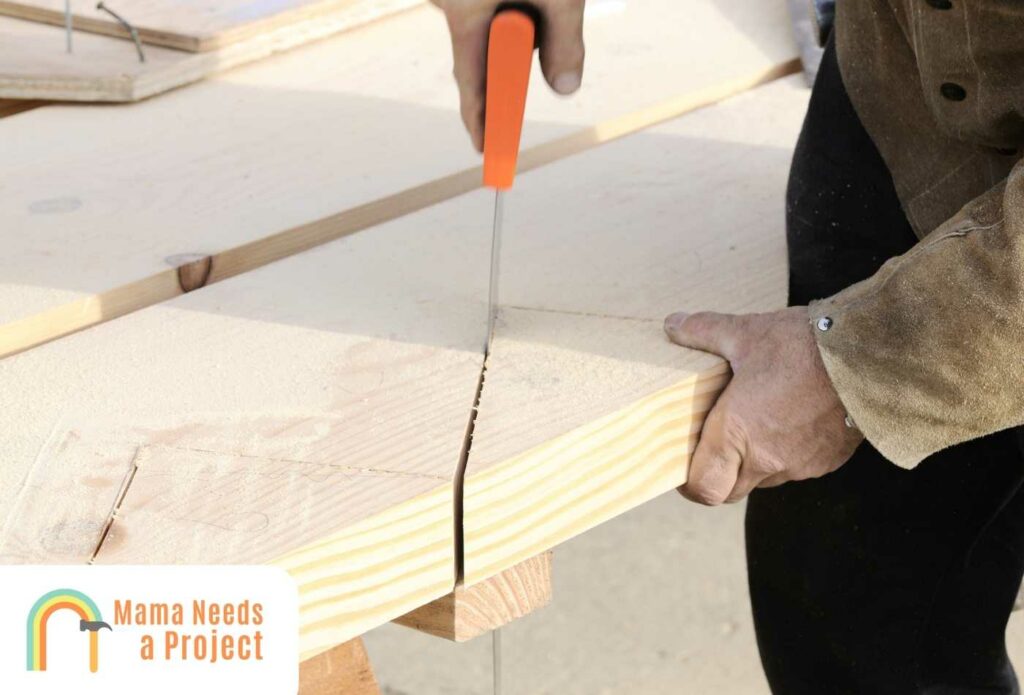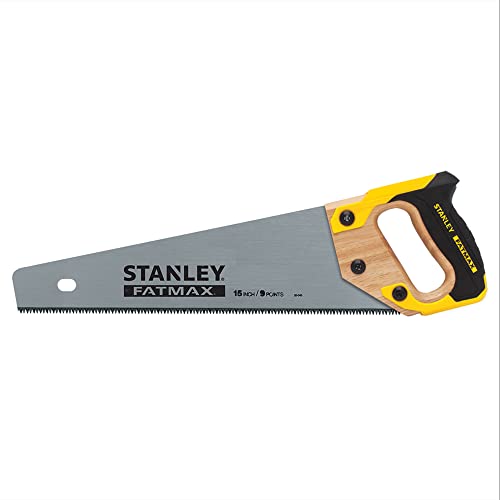Best Hand Saws for Woodworking (2024 Guide)
Hand saws can be extremely handy when it comes to woodworking. Instead of breaking out a power tool to get a simple cut done, using a hand saw makes sense. It’s fast, easy, and no cords that get in the way. What’s not to love!?
That said, it’s critical to pick a hand saw with a sharp blade so you can ensure a clean and precise cut.
That’s why I put together this list of the best hand saws for woodworking.
If you’re in a hurry, I recommend the Irwin ProTouch hand saw because of its mix of quality, affordability, and variety of use cases.
No matter which hand saw you choose, it’s hard to go wrong with any of them on this list. Let’s dig in!
Quick Answer: Here are My Favorite Hand Saws for Woodworking! 👇
Best Hand Saws for Woodworking
1. Irwin Coarse Cut ProTouch
- This carpenter saw uses M2 tooth technology and Tri-Ground teeth for fast, efficient cuts
- A Tapered-Pitch nose on this carpenter saw provides improved clearance and stability
- Deep Gullets on this carpenter saw remove chips quickly
The Irwin Coarse Cut ProTouch is a short, 15-inch panel saw that’s designed for speed and versatility. I listed it first for that reason; if you only have one handsaw, this is the one for you.
The reason it’s so versatile is the design of the teeth.
Instead of a continuous tooth count throughout the blade, there are two sections. The front few inches are finer, at 12 TPI, while the rest of the blade is a medium-coarse 9 TPI. The fine section is great for starting cuts, when you need to be a little more careful. Once you’re started, you can engage the full blade to power through virtually any wood.
The other thing you’ll notice about this blade is the deep gullets spaced out every couple of inches. These provide an outlet for sawdust, so it won’t build up under your blade and gum up your teeth.
I was a little more ambivalent about the handle design. On the one hand, the rubberized, ergonomic design is very comfortable to grip. It’s also angled perfectly for fast, efficient cuts. That said, the bottom extends below the bottom of the blade. When you’re working quickly, it’s easy to bash the handle into the wood.
What I Liked:
- Easy to start cutting
- Excellent balance
- Ergonomic handle
- Useful for many applications
What I Didn’t Like:
- Handle blocks the area behind the teeth
- Not ideal for finish work
My Thoughts
The Irwin Coarse Cut ProTouch hand saw is one of the most versatile hand saws on the market. It’s great for framing and panels alike, and it’s easy to start cuts with. Leaving aside any minor concerns about the handle, the blade is purpose-built for speed. And at only 15 inches in length, it’s easy to fit in your tool bag.
More Stores
2. Stanley FatMax 20-045 Hand Saw
- SharpTooth Saw Technology of the hand saw uses three cutting surfaces to cut 50% faster than conventional…
- Induction-hardened teeth of the handsaw stay sharp up to 5 times longer than standard teeth
- Thick, ergonomically designed grip helps reduce slipping and adds comfort
The Stanley FatMax 20-045 hand saw is another 15-inch panel saw, but with an entirely different design.
If you look at the teeth, they’re consistent along the length of the blade, at 9 TPI. These teeth are made from induction-heated steel, which makes them harder than un-treated steel. In addition, they’re lobsided, with three cutting surfaces per blade. This allows for extremely aggressive cutting without a lot of blow-out.
This saw is great for jobs where speed is the primary concern. The blade is fat and stiff, but it has no gullets, and it tends to curve off to one side or the other. I wouldn’t recommend it for precision jobs. But it’s the perfect tool for rough-cutting or sawing tree branches into sections.
The ergonomic handle is rubber-coated, and has an ideal angle for cutting. The wooden part of the handle is bare at the front, which adds some classic visual appeal.
What I Liked:
- Tough, induction-heated teeth
- Teeth have three cutting surfaces
- Ergonomic handle
- Stronger than most blades
What I Didn’t Like:
- No gullets in the blade
- Hard to cut a straight line
My Thoughts
The Stanley FatMax 20-045 is designed for one thing and one thing only: speed. It’s perfect for rough cuts and it has a nice handle with a rubberized grip. There was one downside – it was more difficult to get an accurate cut with this hand saw. So if precision is important to you, you might want to go with a different option.
More Stores
3. WilFiks 16” Pro Hand Saw
- ► EASY TO USE: Our pro hand saw is designed for precise cutting including dovetails, miters, and tenons. The…
- ► DURABLE CONSTRUCTION: Induction-hardened teeth that stay sharp up to five times longer than standard teeth…
- ► ERGONOMIC DESIGN: Anti-Slip Super Grip handle resists slipping and adds comfort, The handle size will work…
The WilFiks 16” Pro Hand Saw is a slightly longer, 16-inch panel saw – which can make cutting wood faster than shorter saws.
The blade has three cutting surfaces per tooth, which makes it very aggressive and efficient. It also has gullets along its length to help clear sawdust. The handle is entirely rubberized, with a smooth surface that’s surprisingly grippy. It won’t slip out of your hand easily, even if you’re dripping with sweat.
This saw is a bit of an oddball. It’s capable of very fast cutting, but the cuts are also surprisingly clean. Even when you’re working very quickly, there’s not a lot of blowout. That said, you can’t cut smaller pieces like dowls because they’ll hang up in the gullets. You also have to be careful about tough materials like oak, hickory, and pressure-treated woods. These heavy-duty materials will snap teeth clean off the blade.
What I Liked:
- Three cutting surfaces per tooth
- Suitable for many types of work
- Ergonomic, non-slip handle
- Lightweight and easy to manage
What I Didn’t Like:
- Not suitable for heavy-duty jobs
- Wide gullets can hang on smaller pieces of wood
My Thoughts
The WilFiks 16” Pro Hand Saw is an excellent all-around saw for cutting pine, cedar, and other lightweight woods. Its blade is capable of accurate, high-speed cutting, which is a tough balance to achieve. My only complaint with this hand saw was working with hard woods. So if you do plan to work with harder woods, you should opt for the Irwin or Stanley hand saws.
More Stores
4. Suizan Japanese Pull Saw

- JAPANESE STYLE PULL SAW: This product is a “Pull Saw.” Most people are used to European saws, called…
- JAPANESE STEEL: All SUIZAN Japanese saws consist of top quality Japanese steel. The high-quality steel makes…
- MADE IN JAPAN: All SUIZAN woodworking tools are manufactured in Japan by Japanese master craftsmen. The whole…
The Suizan Japanese Pull Saw has a different design altogether but it’s still a quality hand saw worth considering.
It has a straight wooden handle with a wicker grip that’s surprisingly comfortable. At the front of the handle is a 9-1/2” rectangular blade, with teeth on either side.
The teeth on each edge of the blade have different designs. One edge has a jagged row of 9 TPI teeth, perfect for making rip cuts. The other edge has three-sided 15-TPI teeth, designed for extreme precision and near-zero blowout. The blade is 0.2-inch thick, which makes it surprisingly tough and difficult to damage. Then again, it also cuts fairly slowly and is prone to binding.
What I Liked:
- Very clean cuts
- Double-sided design for different types of cuts
- Extreme precision
- Fat, 0.2-inch replaceable blade
What I Didn’t Like:
- Takes longer to cut
- Binds easily
My Thoughts
If you’re looking for precision above all else, look no further than the Suizan Japanese Pull Saw. Not only is it precise, but the double-sided blade makes it versatile enough for rip cuts and crosscuts alike. This is a high quality hand saw made of premium quality Japanese steel that makes cutting wood a breeze.
More Stores
5. Gyokucho 7″ Razor Ryoba Saw
- One side for cross cut, the other for rip sawing
- Blade length 7″, Overall length 15″
- Compact enough to fit in a tool bag
The Gyokucho 7” Razor Ryoba Saw is engineered for highly-detailed work. The 0.5mm blade isn’t suited for heavy-duty materials, but it’s perfect for dovetails and other complex, high-precision cuts.
The blade is similar in design to the Suizan’s, but with more difference between the two sides. The rip cut side has a coarse, 8-TPI design for faster work. The crosscut side has an ultra-fine, 17-TPI design for clean, blowout-free cuts.
The handle is straight, but it’s rubberized and heavily-padded, which makes it very comfortable to operate. That’s all for the good, because you’ll be making a lot of strokes; like any pull saw, the Gyokucho only cuts on the pull stroke, not the push stroke.
What I Liked:
- Ultra-clean, precise cuts
- Near-zero blowout
- Ergonomic handle
- Double-sided design for different applications
What I Didn’t Like:
- Takes longer to cut
- Not suitable for heavy-duty jobs
My Thoughts
The Gyokucho 7” Razor Ryoba Saw is the ultimate precision woodcutting tool. It’s not fast, and you won’t power through a huge project with it. But when you need perfect, intricate cuts, it’s a superb hand saw for the job. This one is very similar to the Suizan hand saw, except the blade is slightly shorter.
More Stores
6. DeWalt 6″ Carbon Steel Jab Saw
- Aggressive Tooth Design of the hand saw cuts up to 50% faster than traditional tooth designs
- The handsaw has multiple material usage for use on drywall, plastic and other building materials
- Induction-hardened teeth stay sharp for long life
The DeWalt 6” Carbon Steel Jab Saw might not seem like a great woodworking saw at first. Its sharp point is made to slam through drywall, and the coarse, 8-TPI teeth will tear through your sheetrock in no time.
Then again, this saw also has plenty of woodworking applications. While you won’t be doing any fine work, it’s great for opening up holes with. If you drilled a hole in a stud to run wiring, only to find that it’s a smidge too small, you can open it up with this. The induction-hardened teeth are more than tough enough for pine, and many hardwoods.
While the handle is small, it’s rubber-padded and well-contoured for a firm grip. And with a blade length of only 6 inches, it’s easy to carry with you and store.
What I Liked:
- Cuts drywall as well as wood
- Tough, induction-hardened teeth
- Comfortable rubberized grip
- Compact design
What I Didn’t Like:
- Very rough cut
- Won’t cut heavy-duty materials
My Thoughts
The DeWalt 6” Carbon Steel Jab Saw isn’t constructed for detailed work. But for small, rough jobs in soft wood, there’s no better saw for the task. With a 6 inch blade it’s small enough to take with you and easily store but it’s also incredibly sharp constructed with a durable steel blade.
More Stores
7. Shark Corp 10-2410
- Raker Tooth for cleaning the sawdust out of the kerf as the blade is pushed forward
- Diamond-Ground for extreme sharpness and smooth cuts
- Impulse Hardening for twice the blade life of standard tools
The Shark Corop 10-2410 is a unique pull saw that’s designed for extreme precision. The 11-inch blade is very thin, at only 1/32-inch. It leaves a minuscule kerf behind it, and the 19 teeth per inch all but eliminate blowout. Be careful, though; I found that it’s somewhat easy to bend with too much pressure.
The teeth are designed to cut on the pull stroke only. On the push stroke, the backs of the blades sweep sawdust out of the kerf, allowing for a cleaner cut. The rubberized grip is comfortable and non-slip, so you can use it all day long.
This is an amazing hand saw for making precise straight cuts because of how sharp the saw blade is.
What I Liked:
- Very thin blade
- Ultra-clean edges
- Extremely accurate
- Non-slip rubberized grip
What I Didn’t Like:
- Blade is easy to bend
- Cuts very slowly
My Thoughts
If you need ultra-fine cuts and don’t care how long it tapes, the Shark Corp 10-2410 is the saw for you. This is one of the best hand saws for cutting dovetails and making other precise cuts thanks to its sharp blade.
More Stores
8. Robert Larson Coping Saw
- Country of Origin:Germany
- Package length:7.0″
- Package width:16.0″
Looking for more precision when cutting? Coping saws are your best bet, and this hand saw from Robert Larson is a superb choice.
Made in Germany with the finest materials, this coping saw is built to last. You can easily replace the blade and adjust the tension on this saw making it a great hand saw for woodworking.
What I Liked:
- High quality components
- Perfect for detailed jobs
- Affordable
What I Didn’t Like:
- Can only be used for detail work
My Thoughts
If you need a saw for detailed cuts, the Robert Larson coping saw is a great option worth considering. It’s a quality hand saw that’s built to last with components from Germany. It’s affordable and easy to use – just be aware that if you need to make a cross cut, this isn’t the best choice.
More Stores
Types of Hand Saws

For such a simple tool, hand saws come in a staggering number of shapes and sizes. Here are a few of the most common varieties of hand saws:
- Panel saws – A panel saw is what you probably picture when you imagine a wood saw. It has a broad blade, ranging from around 12 inches up to 26 inches or more. The handle is angled slightly forward, which makes for an easier grip. Panel saws are ideal for general cutting and framing, for everything from plywood to 2x4s.
- Hacksaws – A hacksaw consists of an arched frame, with a handle on one end. In the open side of the frame is a removable blade, typically measuring between 10 and 12 inches long. These saws have fine teeth that are useless for cutting wood, but they make quick work of metal and plastic.
- Pull saws – A pull saw is designed to be operated by pulling it towards the user. It’s slower than an ordinary wood saw, but it offers an extreme level of precision.
- Jab saws – Jab saws have a point at one end, designed to punch through material like drywall. Like hacksaws, they have little use for cutting wood, but it can still be wise to keep one in your toolkit.
- Folding saws – Folding saws fold down into their handles for portability. They generally have larger teeth and aren’t as precise as pull saws or panel saws. But they’re great for quick, rough work in the field, and they don’t take up much space in your tool bag.
- Coping saws – A coping saw is commonly used in carpentry and woodworking to carve out precise details and shape wood in your project. The blade is extremely thin and they include a large open frame. You can find my list of the best coping saws here.
- Dovetail saws – A dovetail saw is commonly used for cabinetmaking and other work where precision is critical. This type of hand saw features fine teeth and a straight handle. A dovetail saw will offer more power over a coping saw – but less than other hand saws.
Want to learn how to use a hand saw? Check out the video below!
Features to Look For in a Hand Saw
What features should you be looking for when you decide on a hand saw? Here’s what you should look at when buying a hand saw!
Tooth Count
Saw blades are measured in teeth per inch (TPI). This is perhaps the most important consideration, because it impacts so many aspects of your saw’s performance. It affects the type of job the blade can be used for, as well as what types of material it’s suitable for cutting.
There’s no “better” or “worse” TPI count. Instead, blades with a lower TPI will leave a coarser cut, while blades with a higher TPI will leave a cleaner cut.
As a result, hand saws that are designed for finer cuts tend to have a higher TPI. Coping saws, for example, are designed for very fine work. High-TPI blades can also be a better choice for delicate materials like veneer board, while low-TPI blades can damage them.
Hand saws that are designed for rougher work, on the other hand, tend to have a lower TPI count. These saws are great for framing work, rough-cutting panels, or cutting heavy beams. They also tend to be better-suited for treated lumber and green lumber, which are more resistant to cutting.
Hacksaws are somewhat of an anomaly. They tend to have a higher TPI count, but still produce rougher cuts that need to be filed down. That’s because of the unique demands of metal and plastic, which won’t cut at all with a low-TPI blade.
As a general rule of thumb, wood saw blades fall into three categories:
- 7 TPI or less is normally considered a coarse-toothed blade.
- 8 to 11 TPI is a medium-toothed blade.
- 12 TPI or more is a fine-toothed blade.
Identifying the ideal hand saw can be hard, because there are so many woodworking tasks you can perform. Trimming tree branches is nothing like cutting trim, and sawing panels is another matter entirely. A saw that’s perfect for one task will be ill-suited for the others.
It would be impractical to list all the possible applications for wood saws. Instead, here are some general guidelines:
Use a low-TPI saw for tougher materials or faster work. The larger teeth will tear out larger pieces of wood with each pass, so you’ll get the job done more quickly. That said, these same large teeth tend to leave a ragged cut.
Use a high-TPI saw for more delicate materials or jobs that require more control. You won’t clear as much material with each pass, but the cut will be cleaner overall. You can also be more precise, since you’re only removing a little bit of wood at a time.
Blade Flexibility

Most hand saw blades have some flexibility to them, which is a bad thing. When a saw bends, it can make it far more difficult to create a straight cut. If you don’t work with the utmost care, your cut will end up veering to one side or the other.
This mostly relates to the thickness of the blade. A fatter blade will be straighter, and a narrower blade will be more wobbly. Then again, this is a tradeoff. A fat blade requires more effort to push through the wood, while a narrow one has an easier time making a pass.
Hacksaws present an interesting solution to this problem. By putting a thin blade under tension, they provide the same rigidity as a fatter blade.
Blade Contour
As much as tooth count and flexibility are important, the shape of the blade also has a major role to play. Here are some common blade shapes:
- A panel saw has a long, wide blade with a straight cutting edge and big, fat teeth.
- Pull saws and other fine woodworking saws have thinner blades that are designed for precise cuts. These thinner blades are capable of cutting a smooth curve, which is often necessary in woodworking.
- Jab saws have narrower blades with sharp points and long, jagged teeth that are specialized for cutting drywall.
- Hacksaws have thinner blades with finer teeth and no irregularities. This design makes it easy to cut through metal, since the saw doesn’t have to cut out excess material.
Blade Tension
A flexible blade needs to have a consistent tension throughout the blade length. When you apply pressure near the tip, it should bend in the same way as it bends when you apply pressure near the base. If the tension is inconsistent, you’ll have a harder time cutting consistently around a curve. A well-engineered blade should also spring back into its original shape when pressure is removed.
Some hand saws are engineered with an adjustable tension. The most obvious examples are hacksaw blades, which have tension screws on either end. You can pull them tight for normal cutting, or loosen the tension a bit if you want to make a curved cut.
Handle Design
You operate a hand saw with your hand – it’s in the name! If the handle is uncomfortable, you’ll get blisters. If it’s not easy to control, you’ll have a hard time making accurate cuts.
Modern hand saws often have rubberized, ergonomic grips to provide the maximum possible comfort and control. If you’re using your saw every day, you should probably look for a comfortable handle.
That said, many hand saws still come with classic wooden handles. These aren’t quite as comfortable to grip, but there’s no denying that they look beautiful on your workshop wall.
Length
Hand saw length is measured from the front of the blade to the back; it does not include the handle.
All things being equal, a longer saw is better. With each pass of the blade, you’ll cut further through the wood, which means you’ll need fewer strokes to complete your cut. Moreover, longer blades are able to provide a straighter, more consistent cut.
Then again, shorter blades have their benefits.
If you’re on the short side, you probably won’t have the reach to make a full stroke with a 26-inch panel saw. Shorter hand saws are also more convenient to carry around in a tool bag.
There’s no right or wrong answer here when it comes to picking a hand saw. It’s more personal preference.
Hand Saw FAQs
Can I sharpen my hand saw?
For fine-toothed saws, there’s no good way to sharpen them at home. But for a coarser-toothed saw, it can be done. First, position your saw blade-up in a vise, with pieces of scrap wood to either side to keep it from barring. Then, carefully use a double-cut file to shave the teeth down to an equal height.
Do I have to lubricate my hand saw?
Ideally, yes. You should lubricate your blade after every use. Lubricant will keep the blade from rusting, as well as make it easier to move through your wood. You can use pretty much any grease, from WD-40 to paste wax to gun oil. No need to apply a ton of it; a light coat will do.
Why are my cross-grain cuts always so ragged?
Cross-grain cuts are ragged by nature. Because the wood grains are unsupported on the open end, they can easily separate under the saw’s shear forces. On framing cuts, this isn’t a big deal. For cosmetic cuts, use a pull saw or another wood saw with a fine-toothed blade. Cuts also tend to be cleaner if you work slower.
How do I start a cut with a hand saw?
After you’ve drawn your cut line, use the thumb on your free hand to line up the blade. Remember that the blade itself has thickness! To get the perfect length, position your blade just to the outside of your line. Start with the teeth closest to the handle, and pull the saw towards you at a 45-degree angle. Perform a few more of these pull cuts to make a little notch to get yourself started. After that, you can move the saw in a smooth, back-and-forth movement to finish the cut.
Final Thoughts on the Best Hand Saws for Woodworking
There’s certainly no shortage of hand saws on the market, but there’s a massive difference between the top tier hand saws and the budget friendly options.
If you’re looking for the best of the best hand saw, I recommend the Irwin Coarse Cut ProTouch saw.
For more detailed work, the Suizan Japanese Pull Saw. This hand saw contains a great mix of power and precision.
For extremely detailed work, the Robert Larson Coping saw is your best bet.









